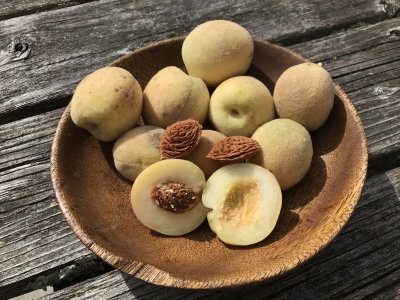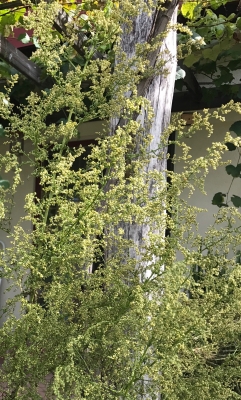Taste And Aroma
Old Peaches
The peaches on a friend’s tree were small, marred with bacterial spot disease, and still showed some green on their skins. So burdened with fruits was the tree that it had burst asunder from their weight, splitting one of the main limbs.
Still, the friend insisted that the peaches tasted good. As further enticement, the tree had a history, having sprouted on the grounds of a nearby 18th century house that had an orchard. The tree was evidently cold hardy also. So I twisted one fruit off and took a bite. In spite of being not quite ripe, the fruit was delicious, quite sweet — as is usual with white peaches such as these — and with an old-fashioned, intensely peachy flavor.
I took up the offer to take a small bag of them home with me. And not only for eating. My plan is to save the seeds from many of them for planting and for making into new trees that should taste very much like their mother tree. Peaches are self-pollinating, in contrast to apples and pears, so progeny often resemble their parent. Peaches also bear within just a few years from seed so I could weed out some or all plants whose fruits were not up to snuff.
The first step to a peachy future was to crack open the shells surrounding each seed, and then drop the seeds into a plastic bag filled with potting soil on the workbench in my unheated garage.
In their natural environment, peach seeds ripen in summer but wouldn’t sprout until spring. If they sprouted immediately, winter cold would likely kill the very young seedling. Hormones within the seeds sense when winter has ended by the number of accumulated hours at cool (30 to 45°F) temperatures.
The number of hours depends on the genetics of the tree but for most hardy fruit trees, about 1000 hours, or about a month and a half, does the trick. And I do intend to trick them, to give them an early start on the season, indoors. The more they grow each season, the sooner they bear.
I’d like them to sprout in early March, so will put the bag of potting soil and peach seeds into my refrigerator in early December. Once they sprout, I’ll pot a few up and, once they emerge from the soil, move them to the sunniest window or the greenhouse, then, when weather warms, outdoors.
It’s a Weed, It’s a Garden Plant, It’s a . . .
Some plants straddle the fence of being defined as a weed. Case in point is Sweet Annie. On looks alone, the plant could easily fall to one side of the fence, qualifying only as a weed. It’s nothing more than a nondescript, upright plant — until it bends over from it’s own weight — that’s green, clumps of them sprouting all over the place. Despite being a member of the Daisy Family of plants, Sweet Annie’s flowers are small, pale green, and not notable.
I, and many other gardeners, grow the plant for its rich, resiny aroma. Bundles of them are for sale from many farms at Maine’s Common Ground Fair; it’s the signature aroma there. So I also grow Sweet Annie to bring me back, olfactorily speaking, to my good times at the Fair.
As a sometime weed, Sweet Annie is, of course, easy to grow. I first planted it 3 years ago, sowing it, unnecessarily, in pots for later transplanting. No need to plant it again; it self-seeds enthusiastically, my job now being to contain that enthusiasm.
Amazing how that plant can move around. It managed to find its way from the back of my house to the front of my house without going around either side. It manages to sprout in spaces between the bricks of my terraces holding the thinnest slivers of soil.
Sweet Annie is sometimes cultivated as a row crop for harvest and extraction of artemisinin, which has some medicinal uses. As for me, I just weed out plants in the wrong place (as defines a weed), and harvest a few bunches to hang near the door for an olfactory treat as I brush past it.


Is Sweet Annie the same as mugwort? I don’t have the botanical name for mugwort, sorry.
Mugwort is a common name for many artemesia species, but usually refers to Artemisia vulgaris, which is much coarser looking than Sweet Annie, does not have a pleasant aroma, and is a perennial that spreads aggressively via underground runners.